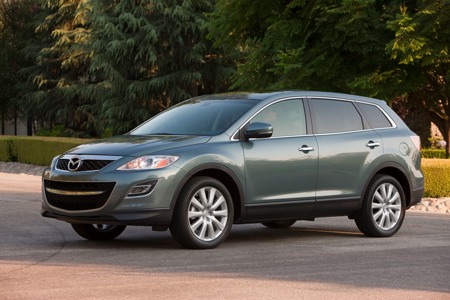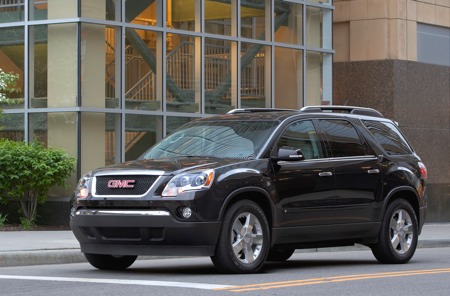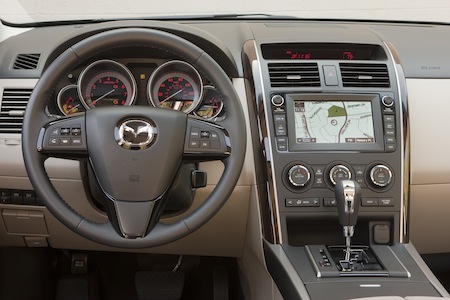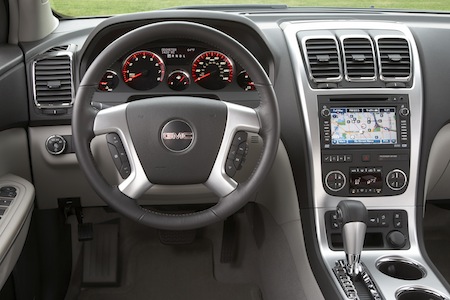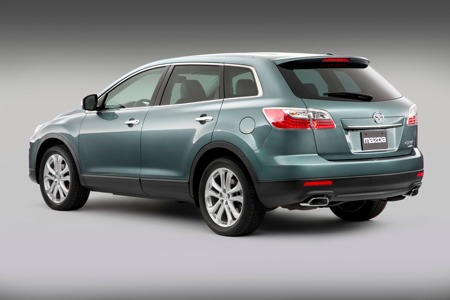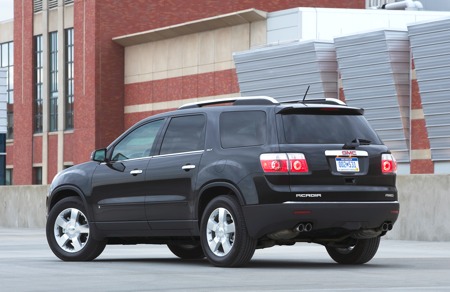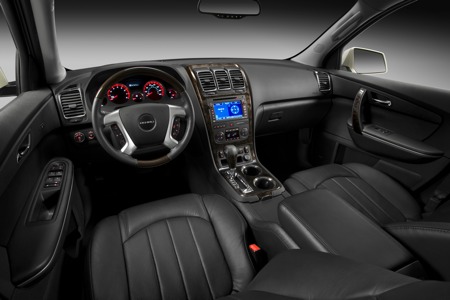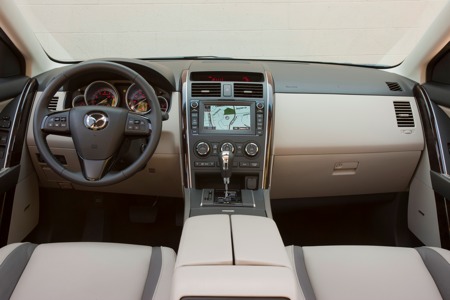Two Three-Row Crossovers Take Different Paths
- September 17, 2011
- GMC, Mazda
- Posted by Dave Sullivan
- Comments Off on Two Three-Row Crossovers Take Different Paths
The model year was 2007. ‘Crazy’ by Gnarls Barkley was popular on the radio. Steve Irwin, the famous crocodile hunter was killed by a stingray and minivans were about as cool as Barney. Two new three-row crossover SUVs entered the market looking to haul families and mass quantities of Vitamin Water from Costco in style and safety.
Fast forward to about the Summer of 2011. The CX-7 and GMC Acadia really haven’t changed that much since that 2007 model year launch. Both are still within a half an inch of each other in length. Both have 270 lb-ft of torque from either a 3.6L or 3.7L V6 mated to a six-speed automatic. Both have Bose audio systems. Both were replacements for minivans. They seem like fairly comparable vehicles at first glance. Once you step inside each of them, you can tell they’ve aged about as well at Joan Rivers. The dot matrix displays and hard plastics are a sign of penny pinching in the last decade but they’ve each had a slight nip and tuck and a little more luster put under the hood since launch.
Once inside, you realize they both suffer from the same Atari-like navigation system. I’d have a hard time paying more for either of these navi systems. I was waiting for Millipede to come across the screen. My top-of-the-line Grand Touring CX-9 didn’t have a USB/iPod jack. The Acadia did but it was almost useless. It was hidden (can you see the bin door in the pictures? Nope!) in the storage bin at the top-center of the instrument panel. This small cubby turns into a Viking convection oven when the sun shines on it, deeming your lithium battery-equipped digital music player worthless. You’ve been warned.
In the rear, they both have interesting ways to fold and tumble the second row seats. I’d probably give the nod to the Acadia here. Slightly smoother and easier operation but the secret sauce isn’t the design of the seats. It’s in the wheelbase. The Acadia comes in at a 118.9-inch wheelbase while Mazda settled for a 113.2-inch wheelbase. Both measure up at 200-inches of overall length. That five-plus inches of wheelbase space helps make access easier in and out of the third row in the Acadia.
Another benefit to the larger wheelbase is legroom. The cabin of the CX-9 feels cramped while the Acadia feels roomy and spacious. Mazda claims 39.8-inches of second row legroom while GMC comes in with 36.9″. I can’t explain this number or how they got it but I know what it feels like to be 6’3″ and sit in the back of both of these vehicles.
So, both of these vehicles were designed to replace minivans. Neither of them have sliding doors. Both have all-wheel drive capability. So how do they stack up at being faux minivans? Well, the Acadia slams the CX-9 with incredible cargo carrying capability. The Acadia has 116.9 cu-ft of space with the middle and third rows folded flat and the CX-9 has 100.7 cu-ft of space. For comparison, the 2011 Honda Odyssey has 148.5 cu-ft of space. Ok, so neither are minivan capable in that regard.
Neither can really replace the capability of a minivan, so why buy one? With the CX-9, the answer is clear. You may sacrifice the ability to haul all of that Vitamin Water from Costco but you’ll at least enjoy the drive to Costco. The CX-9 feels lively and almost entertaining compared to the Acadia which feels like it was tuned by Mr. Whipple. Most fathers, like myself, might object to a minivan and are willing to compromise for a three-row crossover to retain our dignity and man card. While both are worthy of buying, they are certainly for different reasons. The CX-9 has a fast, and dare I say, “zoom-zoom” appearance to it. The long windshield gives the CX-9 a very fast profile. The rear hatch is shaved off a bit compared to the boxier Acadia, eating up cargo space but giving buyers something better to look at than a slab-sided crossover.
So, the Mazda is more lively to drive but it is also priced significantly lower than the Acadia. A gussied up Acadia Denali rings up to almost $50,000. The Cx-9 Grand Touring comes in about $10,000 less and has many of the same features such as HID headlights, automatic climate control, heated seats, and a DVD player.
The Acadia has been a winner in the sales circle every year but for that doesn’t mean the Mazda should be counted out just yet. The CX-9 really does look great. Yes, it is an older design relative to the rest of the automotive market but it has aged fairly well from the outside. The Acadia resembles the other Lambda platform siblings and is much lower to the ground, giving it an almost super-sized station wagon appearance. Both suffer from an abundance of hard, low cost plastics every where you look. Interiors have come a long way since these two were introduced. So, is there a clear winner here? Not exactly, because both try to please different types of people but accomplish many of the same tasks. If you like a sportier appearance and getting a lot of value for your dollar plays a big part of your purchase, you should look at the CX-9. If you need the maximum amount of cargo carrying capability and like a lower step in height, take a look at the Acadia. Both are outstanding vehicles that were some of the first to move into this segment and will continue to please people of different crossover faiths for years to come.


